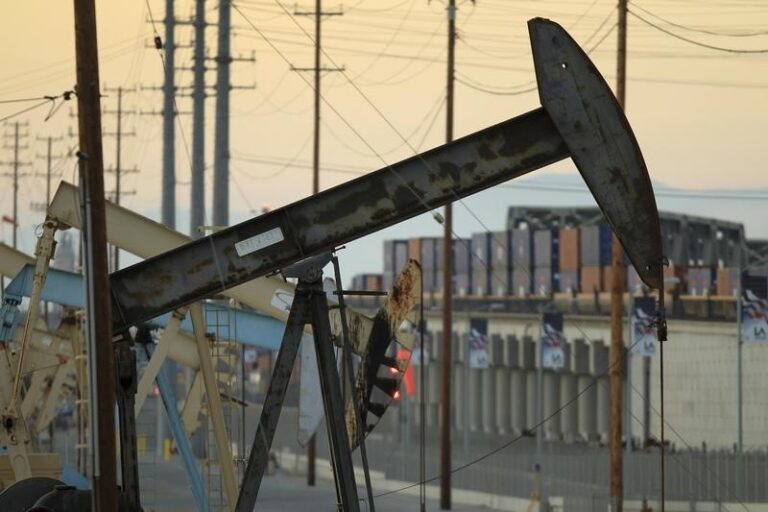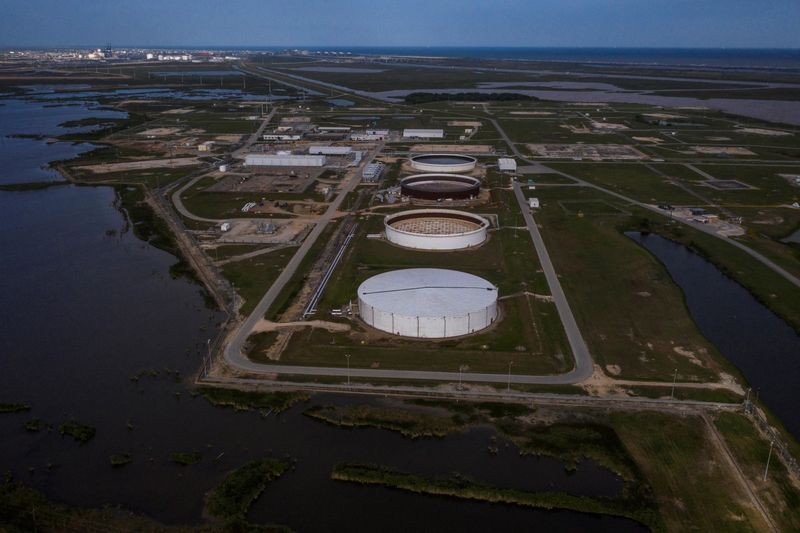
[ad_1]

© Reuters. FILE PHOTO: The Bryan Mound Strategic Petroleum Reserve, an oil storage facility, is seen in this aerial photograph over Freeport, Texas, U.S., April 27, 2020. REUTERS/Adrees Latif/File Photo
By Ahmad Ghaddar
LONDON (Reuters) -Oil prices extended losses on Wednesday after plunging 5% in the previous session, as investors fretted about the health of the U.S. economy ahead of an expected Federal Reserve interest rate hike later in the day.
futures fell $1.07, or 1.4%, to $74.25 a barrel by 0818 GMT, while West Texas Intermediate crude (WTI) fell $1.15, or 1.6%, to $70.51.
Both benchmarks closed at their lowest since late March in the previous session, when they also recorded their biggest one-day percentage declines since early January.
“The Federal Reserve is expected to deliver another quarter-point increase later today as part of its long-running battle against inflation,” PVM Oil analyst Stephen Brennock said.
He added that concerns about the health of the U.S. banking sector and downbeat U.S. jobs data “did nothing to dispel fears that the U.S. economy is barrelling towards a shallow recession”.
The Fed is expected to hike interest rates by an additional 25 basis points on Wednesday to combat inflation, while the European Central Bank is also expected to raise rates at its regular policy meeting on Thursday.
More hikes could slow economic growth and hit energy demand.
Regulators seized First Republic Bank (NYSE:) and sold most of its assets to JPMorgan Chase & Co (NYSE:) on Monday, in a deal to resolve the largest U.S. bank failure since the 2008 financial crisis and draw a line under lingering banking turmoil.
In Australia, the central bank stunned markets by hiking its cash rate on Tuesday and warned that further tightening may be needed to combat high inflation.
Concerns about diesel demand in recent months, meanwhile, have pushed down U.S. futures to their lowest level since December 2021.
Energy prices are also under pressure after data from China over the weekend showed manufacturing activity fell unexpectedly in April. China is the world’s largest energy consumer and top buyer of crude oil.
The reopening of China’s economy will be pivotal for Asia, the International Monetary Fund said as it raised its economic forecast for the region on Tuesday. But it warned of risks from persistent inflation and global market volatility driven by Western banking-sector woes.
Meanwhile, stockpiles fell for a third week in a row for the first time since December, down some 3.9 million barrels last week, according to market sources citing American Petroleum Institute figures on Tuesday.
Official stockpile data from the U.S. Energy Information Administration is due at 10:30 a.m. EDT on Wednesday.
A Reuters survey found that OPEC oil output fell 190,000 barrels-per day in April, mainly driven by Iraq and Nigeria. Output is set to drop further in May as a new round of voluntary cuts unveiled on April 2 takes effect.
Morgan Stanley (NYSE:) lowered its forecast for Brent prices to $75 a barrel by year-end.
[ad_2]